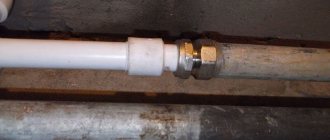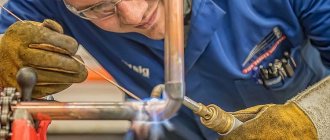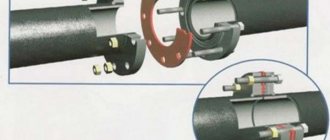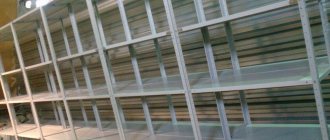Metal pipes have been obsolete for some time now.
They are being replaced by plastic analogues. In terms of their performance characteristics, they are not inferior to metal ones, and sometimes even surpass them. The correct connection of a metal pipe with a polypropylene pipe becomes the key to the fact that the system will work without interruption, with maximum reliability.
How to connect polypropylene pipes with metal ones?
Situations when it is necessary to connect a polypropylene product with a metal one are not so rare.
To understand how to properly connect polyethylene pipes with polypropylene or metal, watch the video lessons posted in this article.
There are several ways to correctly make a connection.
- With thread. Suggests they use fittings that look like couplings. One end is provided with a metal thread, and the other with a cut, with perfect smoothness.
- Flange type. When bolts with studs tighten the structures of the flanges themselves. They will help you understand how to connect polypropylene pipes; the videos will make the process more visual.
Seven ways to connect polypropylene pipes without soldering and welding with your own hands - step-by-step instructions with photo and video lessons.
Briefly about the main thing
Plastic pipes are made from three types of raw materials: polyethylene, polypropylene, polyvinyl chloride. Metal ones are made mainly from steel and copper, cast iron is less often used. Polypropylene and steel are most often used to install a heating system or water supply.
There are a number of ways to connect pipes made of different materials: using fittings, Gebo fasteners, flanges, clip lining, crab fasteners or clamps. Welding is only suitable for joining homogeneous materials, but if a metal tip is put on a plastic pipe, then this method can also be used.
All of the methods listed are not homemade and the components for their use are freely available. The main thing is to understand the system itself and purchase the necessary fasteners of the appropriate size.
We install threaded fittings
These types of connections are relevant if pipes of medium and small diameter are taken together. Their size should not exceed 40 millimeters.
The threads on the fittings are present not only on the inside, but also on the outside. It is needed to secure the metal sides and ends to the parts. The smooth cut of the coupling is located on the opposite side. It involves soldering plastic.
The fittings are installed using simple technology.
- The workpiece is cut at a right angle, in the place where the joint is expected to be located. Solid oil is used to process the edges. Then they take the thread cutter and finish processing.
- After this, they must be cleaned so that there are no metal shavings. For the future joint, it is impossible to do without sealing, which involves the use of FUM tapes or tow.
- The fitting structure is screwed onto the part with a cut, with preliminary preparation. This doesn't require too much effort. The part may crack if you press too hard on it with tools.
- The smooth cut is screwed onto a plastic pipe. It is easy to understand how to connect a polyethylene pipe to a polypropylene pipe.
The material for sealing is laid out along the thread so that it covers at least 1-2 turns.
Video: how to connect a pipeline
Transition from iron pipe to polypropylene, replacement of a section of pipe
Conclusion and recommendation
In most cases, water supply, drainage and heating systems are installed from metal pipes. This is the norm for apartment buildings. Such pipelines become covered with rust inside and out. They make noise, require maintenance, leak over time, and become clogged.
The solution is to install polypropylene wiring. But it will not be possible to completely change the riser, since the consent of all residents from below and from above is required. You will have to join the metal and polymer with a coupling.
It is important that the connection point is accessible, as leaks may develop over time. It is not difficult to eliminate it if you do not embed the joint into the wall.
Installing flanges
This option is more suitable for those who work with large diameters. Thanks to it, during operation there are fewer problems with access if cleaning is necessary.
The flanges look like flat disks supported on straight bars.
Installation of pipes in the system consists of several stages.
- It all starts with creating an even cut at the ends of the workpieces. The main thing is that there is no dust or shavings inside.
- Then they proceed to putting the flanges on the sections prepared in advance. We place rubber gaskets between the places with the discs.
- Bolts are used to connect flanges to each other. It is important that the tightening is uniform, without applying much force.
It is recommended to separately ensure that the edges of the rubber gaskets do not protrude more than 10 millimeters.
Connection options
There are two ways to combine metal with plastic: using threads or flanges. Each method has its own characteristics. For example, the threaded version is optimal for pipes with a diameter of up to 40 mm. In other words, for residential apartments. The connection between the pipes is made using a special adapter - a fitting. This device is ideal for combination connections. On one side it is made in the form of a smooth coupling for polypropylene, on the other - a threaded connection.
Flanges are only suitable for large pipelines over 100 millimeters in diameter.
How to solder structures?
Polypropylene blanks cannot be joined without a special welding machine, which is called an “iron”. It works when connected to a regular electrical network.
It is better to purchase the materials themselves with a small reserve, in case of possible errors.
The process consists of several stages. This will allow you to understand how to solder a polypropylene pipe.
- Several cuts are made where the joints will be located in the future. Thorough cleaning of the ends is also required. Special marks are made on their surface with a marker. They indicate at what depth the parts inside the heating apparatus should be located. The temperature of the soldering iron should be at least 270 degrees.
- Strictly perpendicular connection of nozzles with a hot soldering iron. The same is done with the ends of other connections.
- Wait 10-15 seconds until melting is complete. Then they get rid of the attachments, and the parts are connected again. They are lightly applied to each other, but turning is unacceptable.
- The parts to be joined must be left in one position for some time until they cool down.
Video: learning how to solder
How NOT to solder polypropylene pipes!
Socket soldering is an option that is used for pipes with a diameter of 40 mm and larger. But it is recommended to trust such work to specialists, only they know about all the features.
It is better to heat the connecting elements from the inside, and the pipes from the outside. Then it will be easier to create nodes that are highly durable. Otherwise, small tubercles form inside, which reduces patency. Blowing out the structure will allow you to forget about such problems.
Features of the “cold” method
It is assumed that compression fittings are used in this case. As far as tools go, a regular crimp wrench will suffice.
The installation process looks like this.
- As usual, work begins with cuts at the ends. After this, you need to check whether the edge is in a perpendicular position. Cleaning the ends from burrs is carried out with a wire wool or fine-grained sandpaper.
- The coupling nut is placed on one end of the pipe. The thread should go to the fitting. Then they move on to using compression rings. They also go to the fitting side, but with long bevels.
- The fitting is threaded onto the surface of the end prepared in advance. The part is inserted into the inner surface until it stops.
- After this, the coupling nut is fully tightened. The system is checked for leaks.
How to properly solder polypropylene pipes with your own hands
What points should you pay attention to when welding?
Professional soldering irons are quite expensive. It is better to purchase inexpensive “amateur” options if the work is not constant. These usually have several running attachments at once. You can rent tools. This will not affect the quality of the final connections.
A stable stand has become a must-have element for almost all soldering irons. Even professionals make connections only if the tool remains stable. It takes no more than 10-15 minutes to heat up the working surfaces.
The connecting nozzles have only 2 parts - the drone, on which the coupling is heated, and also the sleeve, inside of which there is a pipe with the drone.
The nozzle parts are installed on the soldering iron when it is still cold. And only after this the device is connected to the network. Work should begin only when the indicators go out.
How to make the transition from a metal-plastic pipe to a polypropylene pipe
This occurs during the second heating cycle. But the heating time is determined by several factors:
- Type of pipe.
- Wall thickness.
- Diameter of the structure.
All these values are usually indicated in the table that comes with soldering irons.
Answers from experts
Michael:
The plumbers did a terrible job... but in general it was not necessary to install metal-plastic, but to install plastic (cook it without threaded connections). . what's the question? If nothing can be done - everything is sewn up and you don’t want to unstitch it - what are you asking? You can connect, that’s all I can say...
******:
Certainly. I have so. The riser is polypropylene. And I changed the wiring myself to metal-plastic. My advice to you is to wrap the leakage tape more carefully (or change the rubber gasket) and tighten it properly. Something dawned on me - perhaps your leak is not at the mechanical connection, but the polypropylene pipe itself is simply soldered to the connection. (here it oozes)
Mongolian muzzle:
it all depends on the connection, if the so-called “American” then it’s just a disease due to thermal expansion, but my advice is to change everything to polypropylene, less hassle,
Vladimir Yakovlev:
Of course it is possible and the problem is in the connection itself
Michael:
select the necessary adapters and connect, the leak is due to an incorrect connection, and not because of the pipes
Nikolai Ermolovich:
It is possible, but through an adapter METAL PIPE - PLASTIC PIPE this is for water, but you must remember that for hot water and for cold pipes they are different, that is, they are marked with their own markings. For sewage, there are adapters with rubber seals, even for different diameters. for ventilation there are generally no problems if the pipe connection is closed with gypsum, that is, so that you cannot reach the connection later, then it is better to connect also through a special insert using clamps. if the connection is easy to reach, then wrap it with wide electrical tape; if it comes off over time, then it can be rewound. Gutters are the same as ventilation, but you need to keep in mind that according to the certificate, plastic pipes must have a temperature difference, for example, from -50 to +35 degrees C and withstand sunlight. I could also answer how to lay pipes in the ground along the roof, etc. etc. but I think this is enough. If it's not difficult, check out the answer.
Vlad Ternovsky:
if the joint is metal-plastic, it leaks, change the oring or tighten it, and if the joint is plastic, it’s plastic, then you need to resolder it
Grandfather Au:
you need to call a plumber; if the fitting is too long, let him stretch it; if it needs pressure testing, let him change the fitting and a piece of metal-plastic pipe
Heavenly Slug:
That's how they connect. Even before replacing the risers, the wiring was done by Metaloplast. From the riser there is an adapter angle, a ball into it, then a counter and to the mixer.
Belogurov Nikolay:
when does it cool down? When do they stop heating?
Kungurtsev Andrey:
The disadvantage of metal-plastic pipes is that their connections are unreliable and the collet (metal-plastic connection) is not airtight. When using metal plastic in a heating system, over time, these pipes begin to leak at the joints. What can be done? Only if you tighten the joints, drill out the drywall so that a hand with a key can fit through, and then putty this place. But of course you need to use polypropylene for heating systems. otopleniedoma.ucoz
Artyom Lobazin:
It is better to change the entire system or gradually in sections. Just take not old stuff like metal-plastic and polypropylene, but a metal-polymer pipe from Perth type 2. It will last a long time and is easy to install. nanopipes there and video
Can't find a light?:
With a GEBO coupling, if you don’t mind the money:
Goga Ivanov:
of course... insert one into the other and wrap it tightly with tape... :)))
Dr. Silberman:
Certainly. Plasticine. If you don't plan to use it)))
A piece of rubber hose and clamps.
Vladimir Petrov:
If not for a long time, then you can use clamps as described above. But it’s better to find a soldering iron and solder it and then connect it with fittings. There is still pressure and the clamp is somehow not reliable
Alexander:
Perhaps try it on a water supply with low pressure. It may be possible to put a transition coupling for HDPE on the propylene onto the water thread, then a fitting for the metal plastic. Not suitable for reinforced polypropylene. Reliability is questionable; it’s not worth the risk in an apartment building.
Cat's smile:
... Look for a fitting that matches the diameter of polypropylene. Next is a matter of technology and watch the video explanation)… s .youtube m/watch?v=cbHKD038MCM - fitting for HDPE.











